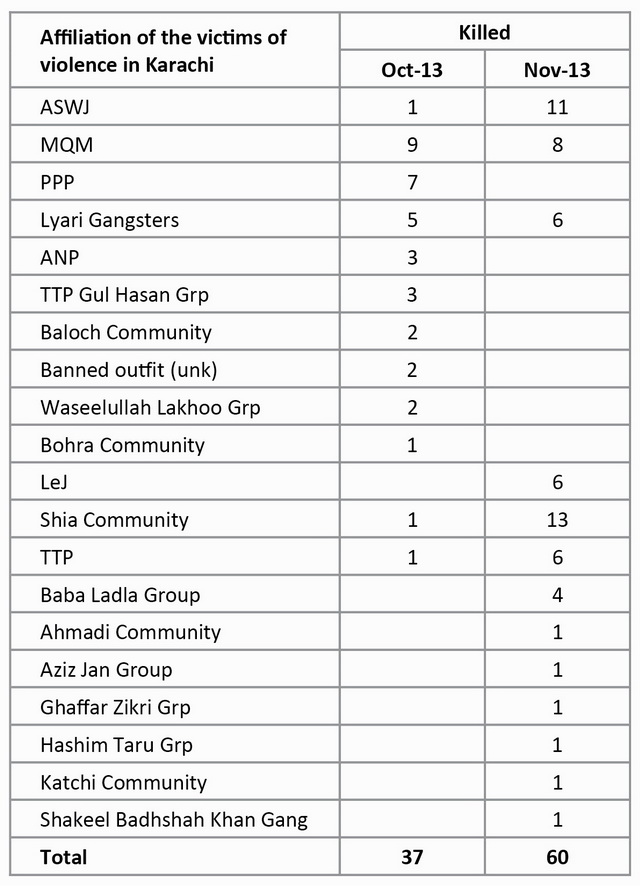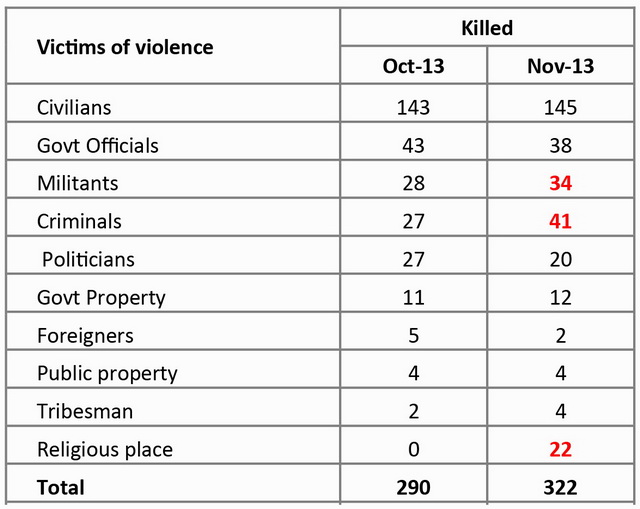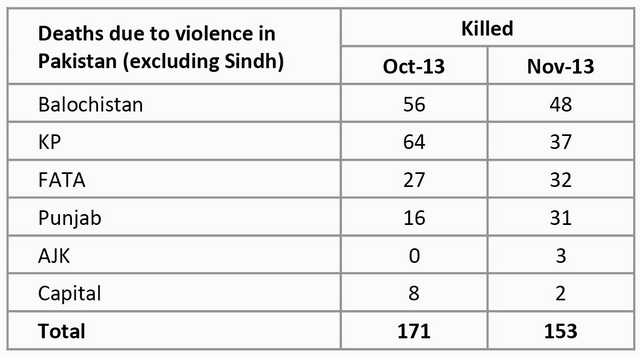Controversial drone attacks, the raging controversy over them and government fledgling initiative on peace talks with the Taliban dominated the mainstream political discourse during the month of November. It clearly exposed socio-political divisions within the society.
The death of the chief of the Taliban, Hakimullah Mehsud, in a drone attack on November one not only practically scuttled ´ at least temporarily – the government talks initiative but also unleashed a deluge of condemnation of the United States for killing Mehsud at an inappropriate time. Most right-wing parties joined hands in censuring the ‘untimely US action’ with some even going to the extent of calling Mehsud ´ known for his brutality ´ a martyr.
Mehsud killing apart, data collected during November suggests that acts of terrorism, violence and reprisals by religious militant declined in the weeks under discussion. However, sectarian violence continued unabated.
CRSS endeavors to make its monthly conflict analysis as informative and credible as possible with the help of open source information, yet statistical errors and omissions remain a possibility. This possibility, however, does not grossly affect the basic objective of this report. This report mainly covers the following topics:
Targeted operation in Karachi
Declining rate of militancy
Sectarian violence
Drone attacks
The CRSS will appreciate receiving comments that the readers may have on this report.
Report prepared by:
Mohammad Nafees
Senior Research Fellow
Center for Research and Security Studies
Data compilation by:
Fariha Farry
NOTE: Readers can approach CRSS for source of any information included in the report. Please send your request to: [mail@crss.pk]
OVERVIEW
Deaths due to violence in November 2013:
A slight rise in the number of casualties was recorded during the month of November. From 568 casualties in October, the figure went up to 640 (320 deaths and 320 injured) in November. This brought the total deaths off violence in the first eleven months of 2013 to about 5390.
Sindh counted the highest number of deaths followed by Balochistan, KP, FATA, Punjab, AJK, and the Federal Capital. Punjab appears to be the safest place among all the four provinces with only about 31 deaths due to violence during the month. It also shows 100% increase in violence compared to the number of persons died last month.
Graph 1: Number of people killed in provinces due to violence:
Graph 2: Trend of violence from Jan ´ Nov 2013:
Table 1: Violence data from Jan ´ Nov 2013:
Targeted operation in Karachi:
Graph 3: Number of persons killed in cities:
Karachi, the capital of the southern Sindh province had the highest number of victims of violence during this month despite the ongoing operation against organized crimes, in the city (Refer graph 3). The largest, economically the most important city of the country witnessed more than 40% rise in human losses, as the number of deaths went up from 111 to 156 during this month. Major factors for this increase can be attributed to the in fights among Lyari gangsters and running feuds among militant arms of various political parties and right-wing groups. Of the 60 identified victims of violence in Karachi, 36 were affiliated with sectarian communities and outfits like Shia community, Ahmadi community, ASWJ, Lashkar-e-Jhangvi (LeJ), and TTP Sectarian (Refer table 2).
Table 2: Affiliation of the victims of violence in Karachi ´ Nov 2013:
Karachi-based operatives of the vicious Tehreek-e-Taliban Pakistan (TTP) appear to have changed its modus operandi in Karachi and resorted to targeted sectarian militancy.
On November 14, three Taliban terrorists, including its senior leader Amirullah Mehsud, were killed during a security operation in Gulshan-e-Buner, Quaidabad, and according to the Rangers ´ a paramilitary force carrying out the anti-crime operation, these terrorists were preparing for attacks on Ashura[1]. In another incident on November 25, two TTP militants involved in sectarian violence were gunned down in what was officially reported as an encounter in SITE area[2].
Declining Violence:
Comparative data on victims of violence for the months of October and November shows that the fatalities of government officials and politicians in November were less than the number of militants and criminals who lost their lives because of violence. In October, it was vice versa (Refer table 3).
Table 3: Comparative data of victims of violence
The possible cause of this decrease in crime rate is the losses of top leaders of the militant outfits like the TTP, Haqqani Network, LeJ, and Punjabi Taliban during this month. The first blow to the Taliban came from a drone attack that killed their chief, Hakimullah Mehsud. Later, on November 12, a top leader of the Afghan Taliban, Dr. Naseeruddin Haqqani, son of the chief of the Haqqani Group, was killed in a target attack near the Pakistani capital Islamabad[3].
For the first time, Taliban became victim of a weapon that they always loved to use against their targets. A suicide bomber ran his explosive-laden car into a vehicle carrying seven Taliban militants in Mir Ali area. Among the dead was Qari Saifuddin, a local Pakistani Taliban commander[4]. One day later, second drone attack of the month killed nine militants of the Haqqani Group in Hangu. Majority of the victims were senior members of the Afghan Taliban who were staying at the madrassa, Taleem-ul-Quran, during the attack[5].
Third drone attack of the month occurred on November 30, in North Waziristan that killed three men who were members of the Punjabi Taliban[6].
Elimination of top level leadership of the two strong militant organizations was a great loss to these outlawed outfits and this can be one of the reasons for the visible decline in violence in the country, excluding Sindh (Refer table 4).
Table 4: Deaths due to violence in Pakistan (Excluding Sindh)
Sectarian violence:
At least 56 persons lost their lives and around 141 were injured in incidents of violence that can be characterized as sectarian in nature. Majority of the victims were from Karachi (36) followed by Rawalpindi (10), Bolan (6), Gujrat (2) and Quetta (2). The province of Punjab that hitherto enjoyed peace and tranquility experienced a deadly wave of sectarian violence that left 10 persons dead and over 100 injured.
This bloodbath took place to the context of a November 7 warning by the Taliban, who had threatened to avenge the death of their chief Hakimullah Mehsud. They had reportedly warned the government of a severe backlash which might spread to the Punjab and target the central PML-N leadership including the ruling Sharif family[7]. Within 10 days after this warning, the people of Punjab witnessed the transformation of this warning into reality. On November 17, a sectarian clash took place in Rawalpindi during a Shia procession that left ten persons dead and eighty injured[8]. Tensions gripped the entire city quickly, forcing the administration to call in the army and impose a curfew i.e. ban on public movement for a certain length of time.
Shia processions that mark the martyrdom of Hussein, the grandson of the Prophet Muhammad, were not the only reason for eruption of sectarian violence in the country. As many as 22 were killed in November at religious places belonging to Shia and Sunni sects (Refer table 4 above). Two Madrassahs ´ religious seminaries, one Sufi Shrine, and two Imambargahs i.e. Shia places of worship, were targeted during this month. One of the Madrassahs in Hangu in northwestern Pakistan was targeted by a drone attack. Here are brief reports of the incidents where religious places were targeted:
November 4, Quetta: An unregistered religious seminary [Madrassah] was gutted as a result of an explosion that occurred, allegedly after explosive materials prematurely went off on the Eastern Bypass, an outskirts of the Quetta Valley[9].
November 14, Karachi: Three Tehreek-e-Taliban Pakistan (TTP) terrorists, including senior leader Amirullah Mehsud, and a Rangers official were killed during an encounter in Gulshan-e-Buner, Quaidabad. Amirullah Mehsud was involved in grenade attacks on Shia worship places in the Quaidabad area and also confirmed that the terrorists were planning to carry out a major attack on Ashura[10].
November 15, Karachi: Three explosions had rocked the city. The first two took place within a short span of 20 minutes in North Nazimabad near a shrine [Dargah Abul Fazal]. The third explosion was reported in Sector 11-B of North Karachi near an Imambargah, [in Sector-11B of New Karachi]. Nine people, including two policemen and two media persons of a private TV channel, were injured in the three explosions. According to police, the banned Lashkar-e-Jhangvi and Jundullah were the prime suspects[11].
November 15, Muzaffargarh: Law enforcement agencies thwarted a major terrorism bid by defusing explosives near the central Imambargah in Kot Addu[12].
November 21, Hangu: The CIA-operated spy planes extended missile strikes to the settled areas of the country and hit a seminary in Thall tehsil of Hangu district, killing nine people, including a senior commander of the Haqqani network. According to sources, senior members of the Afghan Taliban were staying at the madrassa during the attack. ‘The drone hit only two rooms where members of the Afghan Taliban were staying. The remaining rooms of the madrassa, which had nine rooms, remained intact,’ said one member of the Afghan Taliban[13].
Drone Attacks
Four drone attacks took place in FATA and KPK during this month, killing 18 persons and injuring three. The drone attack on a seminary in Hangu on November 21 was only the second such occurrence outside the semi-autonomous FATA regions. It killed nine people including a senior commander of the Haqqani network. Quick to react was Imran Khan, the chief of the PTI and the biggest opponent of drone strikes in the country. Condemning the incident, Imran Khan pledged to take steps for blocking the NATO supplies as a protest against drone strikes. Pleased with such a daring gesture of Imran Khan, the TTP central spokesperson Shahidullah Shahid appreciated the move by saying, ‘Imran Khan has taken a welcome step.’[14]
While the JI and JUI-F called the terrorists martyrs, the ISPR retaliated with a strongly-worded protest saying, ‘By terming a terrorist a martyr, the JI chief has insulted the sacrifices made by the Pakistan Army[15].’ Former director-general of the ISPR, Major-General (R) Athar Abbas said that by killing Mehsud, America had helped Pakistan. Kamran Khan, in one of his programs, said that Pakistan had openly claimed that the drone attacks were more dangerous to the terrorists than to the security of the country[16]. The PPP MNA Nafisa Shah said that Hakimullah Mehsud was declared a terrorist by the Government of Pakistan and he carried Rs 50 million as head money[17]. Defence analyst Brig (R) Asad Munir said that Hakeemullah Mehsud was responsible for killing of thousands of Pakistanis. An expert in defence affairs, Air Marshal (R) Riazuddin Shaikh, said, ‘Two parties which were government allies have politicized the issue. Drones were very important for the country. They were helping the country fight extremism[18].’ Religious parties like the JI, JUI-F, and JuD demanded Islamabad to shoot down drones if Washington did not stop them[19].
Several other politicians as well as critics, however, wondered and questioned as to what the senior members of the Afghan Taliban were doing in the settled area of Pakistan. A sit-in was staged by the PTI of Imran Khan to protest continued drone strikes, blocking hundreds of NATO cargo containers bound for Afghanistan. It forced the USA to look for alternative routes for the NATO supplies.
The Senate of the country also got divided on this issue as some of the Senators condemned the drone attacks while others criticized those who called Hakimullah Mehsud as a martyr. The Awami National Party (ANP) Senator Afrasiab Khattak regretted that a person who killed one or two [persons] faced murder cases while those who killed thousands and thousands of innocent people had been made stakeholders while masses had been kept at bay. ‘Those who removed the national flag are among the stakeholders today while the rulers have forgotten Mohtarma Benazir Bhutto, Bashir Bilour and scores of others and the military men who laid down their lives for Pakistan,’ he noted[20].
The top leaders and other militants who lost their lives in drone attacks during this month are:
November 1, Six TTP activists including their chief were killed in NWA:
Hakimullah Mehsud – TTP commander
Abdullah Bahar Mehsud, deputy to Hakimullah Mehsud
Tariq Mehsud
Three persons were not identified
November 12, ISLAMABAD: Jalaluddin Haqqani son killed in Islamabad.
The witnesses said that the unknown victim [later found out to be Dr. Naseeruddin Haqqani] and a Naanbai later identified as Muhammad Farooq sustained bullet injuries, adding that the colleague lifted the unknown victim in critical condition, put him in the car and sped away towards an unknown place, leaving the other injured person behind.
November 21, Hangu: Nine senior members of Haqqani Group were killed in a drone attack in Hangu:
Maulvi Ahmad Jan was identified as Maulana Ghazi Marjan ´ Haqqani Group
Maulana Hameedullah
Maulana Abdur Rahman
Maulana Abdullah
The identity of the remaining four people could not be ascertained
November 30:
Two Urdu-speaking members of the Punjabi Taliban were killed
One Arab national was killed
Conclusion:
The month of November saw a relative decline in casualties off violence and acts of terrorism but the breakdown in law and order ´ and the eventual response of the federal government to it i.e. the decision to send in paramilitary troops to cleanse the city of crime, as well as the presence of senior Afghan Taliban leaders on the Pakistani territory underscored the security challenges that Pakistan today faces.
Continuing drone attacks remained another bitter reality that angered many Pakistanis but also marked the helplessness of the government. The issue kept fueling resentment and deepening socio-political divisions within Pakistan. Drone strikes immensely annoyed the government, too, for it accused the US of ‘droning its peace initiative.’
Other than Karachi, incidents of violence went down during November but as of now it is difficult to determine whether this underscored the diminished strike capability of the TTP or a lull before another wave of revenge attacks by the dreaded terrorist outfit.
[2] http://www.thenews.com.pk/Todays-News-4-216123-Two-TTP-militants-killed-in-police-encounter
[3] http://www.thenews.com.pk/Todays-News-13-26603-Jalaluddin-Haqqanis-son-killed-in-Islamabad
[6] http://www.thenews.com.pk/Todays-News-13-26978-Three-suspected-militants-killed-in-NWA-drone-attack
[7] http://www.thenews.com.pk/Todays-News-13-26523-Taliban-to-target-Punjab-and-Sharifs-agencies-warn-all
[10] http://www.thenews.com.pk/Todays-News-4-214159-Rangers-prevent-Ashura-attack-kill-three-TTP-men
[15] http://tribune.com.pk/story/630056/ji-chief-should-apologize-for-terming-terrorists-martyrs-ispr/
[16] http://www.thenews.com.pk/Todays-News-2-211784-Drone-attacks-more-harmful-to-terrorists-than-security
[17] http://www.thenews.com.pk/Todays-News-13-26460-Hakimullah-was-declared-a-terrorist-by-government-of-Pakistan-PPP-MNA








